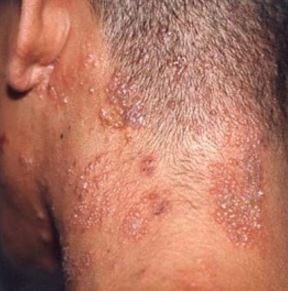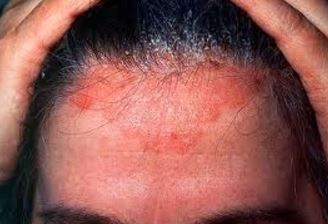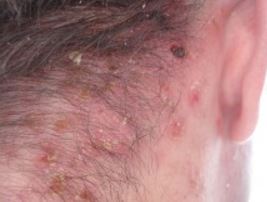Shingles on scalp symptoms include painful blisters, itching or tingling. Shingles is caused by a virus called varicella- zoster. It may appear with or without a rash around the scalp, neck or around eyes. See pictures in the post to understand this condition. Shingles is not contagious. Learn more in the post on how to treat and get rid of shingles.

Shingles on Scalp Symptoms
Depending on the nerves involved, shingles can affect many parts of the body.
Nerve pain- the first symptom of shingles outbreak is pain occurring along the path of the nerve in which varicella-zoster virus has become reactivated. The pain varies in intensity between individuals from mild to very intense. This pain is accompanied by a headache, sensitivity to light, and flu-like symptoms without a fever.
You may also feel itching, tingling, or pain where a band, strip, or small area of rash may appear several days or weeks later. A rash can appear anywhere on the body but will be on only one side of the body, the left or right. The rash first forms blisters, then scab over and finally clear up over a few weeks. This band pain and rash is the clearest sign of shingles.
The rash caused by shingles is more painful and itchy. There are nerve roots that supply sensation to your skin in pathways on each side of your body. When the virus becomes reactivated, it travels up the nerve roots to the area of skin supplied by those specific nerve roots.
Shingles develop in stages;
1. Prodromal stage
This is a stage before the rash appears. This stage is characterized by;
- Pain, burning, tickling, tingling, and numbness occurs in the area around the affected nerves several days or weeks before a rash appears. The discomfort usually occurs on the chest or back, but it may occur on the belly, head, face, neck, or one arm or leg.
- Flu-like symptoms (usually without a fever) – these include chills, stomachache, or diarrhea. These may develop just before or along with the start of the rash.
- Swelling and tenderness of the lymph nodes may occur
2. Active stage
During this stage, the rash and blisters appear.
- A rash may occur on the forehead, scalp, cheek, nose, and around one eye (which may be sight threatening)
- Pain along with the skin rash
- A band, strip, or small area of the rash appears. It can appear anywhere on the body but will be on only one side of the body, either left or right. Blisters will form. Fluid trapped in the blisters is clear at first but may become cloudy 3 to 4 days.
- Blisters may break open, ooze, and crust over in about 5 days. The rash heals in about 2 to 4 weeks and some scars may remain.
3. Post herpetic neuralgia
This is the chronic pain stage. It is a most common complication of shingles. It lasts for at least 30 days and may continue for months or years. The symptoms of this stage include;
- Aching, burning, stabbing pain in the area of the earlier shingles rash
- Extreme sensitivity to touch
- Persistent pain that may linger for years
The pain associated with this condition commonly affects the forehead or chest. This pain may make it difficult for you to eat, sleep, and do daily activities. It may also lead to depression.
Shingles on Scalp Pictures
How does shingles on scalp look like? The picture inserted below is to help you understand the appearance and symptoms of shingles.

Shingles on Scalp and Neck
Shingle is an infection that causes pain and rash along a band of skin supplied by the affected nerve. This condition affects any of the parts of the body and is common in the neck, face and around eyes. The virus causing shingles leads to swelling on one side of the neck, under the jaw or behind ear.

Shingles on Scalp without Rash
Can you get shingles without a rash? Shingles without a rash is called ‘zoster sine herpete’ (ZSH). The chickenpox virus causes all forms of shingles. This virus is also known as varicella zoster virus (VZV). If you’ve had chickenpox, the virus will remain dormant in your nerve cells. This condition isn’t contagious and often occurs in people with compromised immune systems.
If you’ve had chickenpox, the virus will remain dormant in your nerve cells. Experts don’t fully understand what causes the virus to reactivate and why it only reactivates in some people. When this varicella zoster virus reappears as shingles, the virus is known as herpes zoster.
What are the likely symptoms of shingles without a rash? The symptoms of zoster sine herpete are similar to those of shingles but without a rash. The symptoms are usually isolated to one side of the body and commonly occur on the face and neck, and in the eyes. They can also occur in the internal organs. Typical symptoms include;
- A painful burning sensation– this pain is typically described as a deep stabbing sensation that is very severe. Because of the impact on the nervous system, this pain may have an electric feel to it. In many cases, pain will only affect one side of the body and will be localized to a specific area of the skin, though the disease can affect as many as three spinal nerves at a time. As the disease affects the skin, patients may experience a prickling, itching, or numbness on the skin as well.
- Movement problems– if the shingles virus affects the nerves that help control motor function, it can cause the patient to suffer from difficulties in moving properly. You may notice weakness in the arm, leg or abdomen on one side of the body. Some patients also notice difficulty moving one side of the face, including moving or focusing with one eye.
- Flu-like symptoms– patients will often develop flu-like symptoms just before the skin lesions appear. This can include body or muscle aches, headaches, and mild fever, a general feeling of illness or poor appetite. These symptoms can last for 7 to 10 days.
What could be causing shingles without a rash? Doctors are unsure what causes the disease to become active again, though it appears that adults with weak immune systems are more prone to these outbreaks than others. Your immune system may become compromised because of;
- HIV/AIDS
- Chemotherapy or radiation for cancer
- High dosages of corticoid steroids
- High-stress levels especially from surgery or trauma
- Old age especially those over 50 years
- An organ transplant
Since this condition isn’t contagious, you can’t give it to someone else. If you are having this condition and you get in contact with someone who hasn’t had chickenpox or wasn’t vaccinated for chickenpox, you can pass it on to that person. That person would have to come in direct contact with your shingles rash.
If you have shingles without a rash, you shouldn’t be able to pass it on to others. It is therefore important to avoid contact with people who haven’t had chickenpox as well as pregnant women until other symptoms have cleared.
There are several complications associated with shingles without a rash. They can be very severe, particularly if the outbreak goes untreated. Such cases include;
- Past herpetic neuralgia– this condition occurs when the nerve fibers become confused after interaction with the shingles virus. This condition causes the nerves to send exaggerated feelings of pain from the skin to the brain, even after the shingles outbreak has healed.
- Vision loss– if a severe case of shingles occurs around the eye, it may cause vision damage or permanent vision loss.
- Neurological problems– you can have a complete nervous breakdown after suffering from shingles outbreak. This may cause facial paralysis, hearing problems, balance problems or inflammation of the brain.
How is this condition diagnosed? This condition is difficult to diagnose based on the symptoms only. This is because it often goes undiagnosed.
How long do shingles with no rash last? Normally, shingles with a rash usually clear up within 2 to 6 weeks. If you have shingles without a rash, your symptoms should clear up within a similar amount of time.
Shingles on Scalp with Swollen Lymph Nodes
Shingles on scalp is a condition that is typically accompanied by a fever and enlarged lymph nodes. The swollen lymph nodes and rash are accompanied by a burning pain generally located on one side of the body.
Are Shingles on Scalp Contagious?
Are shingles contagious? This condition is caused by a virus, which is spread through direct contact with fluid from the rash blisters caused by shingles. A person with active shingles can spread the virus when the rash is in the blister-phase. Otherwise, the virus is not contagious before the blister appears.
For you to know how long shingles on scalp is contagious, you should understand the symptoms for each stage of this condition. The skin lesions develop 2 to 3 days after the onset of the attack. The rash develops typically in one line which later forms small to large blisters.
Shingles on Scalp and Ear Pain
A rash is the most common symptom of shingles on scalp. The pain from rash behind the ear and on the scalp is felt like sharp stabbing knives. Ear pain or hearing difficulties is a complication you may develop when the condition is not diagnosed in time. This condition is however curable and the following are some of the treatments that might be administered;
- Cold compressing- this helps to soothe and relieve pain in the ear
- Use of pain relievers such as non-steroid anti-inflammatory medications
- Ear drops for relieving itching and irritation inside the ear.
Treatment for Shingles on Scalp
Shingles is most commonly diagnosed and treated by a primary-care physician or an emergency-room physician. For certain individuals who develop complications of shingles, a specialist in ophthalmology, neurology, or infectious disease may also be involved.
The treatment for shingles is aimed at diminishing the effects of the virus, as well as pain management. There are several medications that can be used, and your doctor will discuss the best treatment options for your particular situation.
1. Antiviral medications
These are medications used to combat viral infections. In this case, they are used against the varicella zoster virus. These medications help shorten the course of the illness and decrease the severity of the illness. They may help prevent the potential complications associated with shingles. They are most effective when taken within the first 72 hours of the first appearance of the rash.
2. Pain relief medication
Pain medication can be used to help relieve discomfort caused by the rash, which can sometimes be severe. If you have mild pain, over-the-counter analgesics such as acetaminophen (Tylenol) or ibuprofen may be required. For more severe pain, you may require stronger opioid pain medication.
3. Corticosteroid medication
They include medication such as prednisone is sometimes used in select cases of shingles, such as those with severe pain or neurologic involvement, and must be used with concurrent antiviral therapy.
4. over the counter antihistamine medication
Drugs such as diphenhydramine, may help alleviate localized itching caused by shingles.
5. Soothing lotions and creams
These lotions and creams don’t speed up the healing process, but they can increase your comfort level. (Avoid scented perfumed lotions, which can cause further irritation). You can apply topical ointments containing the natural ingredient capsaicin up to three or four times a day. This is the active ingredient in chili peppers and it contains anti-inflammatory effect to help ease the pain. When you apply the cream, the pain will increase and then go away slowly. This cream works by reducing pain signals sent to your brain.
In addition, you can apply calamine lotion after baths and showers to soothe irritated skin and help dry out blisters.
6. Antidepressant
Some research suggests that low doses of antidepressant medications help relieve shingles-related pain. Some antidepressants block the removal of a neurotransmitter called serotonin. Extra amounts of circulating serotonin may keep pain signals from reaching the brain. You should talk to your doctor to find out if antidepressants can help you cope with the continuing pain.
How to Get Rid Of Shingles on Scalp with Home Remedies
The vast majority of cases of shingles can be managed at home. Several natural remedies may also reduce pain and discomfort.
1. Cool compress
You should apply cool or moist compresses. This helps to relieve pain and itchiness associated with shingles rash.
The following is how this is done;
- Soak a cloth in cold water, and wring out the excess water
- Apply the cloth to the rash and blisters
- Repeat this several times throughout the day in order to relieve symptoms
Daily cleansing of the blisters reduces the risk of spreading the infection. You can also take a healing bath to reduce symptoms. The following is how to go about this procedure;
- Pour 1 to 2 cups of colloidal oatmeal or cornstarch into lukewarm bathwater and soak for 15 to 20 minutes (Note: do not use hot water since it can worsen shingles blisters because the heat increases blood flow).
- Dry your body completely and then wash your towel to avoid spreading the virus to others
2. Baking soda
Baking soda contains soothing effect because of its anti-inflammatory properties. It also acts as a natural acid neutralizer that helps relieve itching. Applying this remedy will make the rash drier and better. The following is how you apply baking soda on your shingle rash;
- Mix baking powder with a small amount of water
- Place the solution on the affected area
- Leave the solution for 10 to 15 minutes to dry and then rinse off with cold water
- Repeat this more regularly until the rash clears
3. Aloe Vera and cayenne pepper
Aloe Vera is a remedy rich with anti-inflammatory, antibacterial and antifungal properties. It also contains great antimicrobial qualities and can help in regeneration of damaged cells in the body. It also contains vitamin E that helps keep the skin moisturized and reduces itching. The following is how to apply aloe Vera to accelerate the healing of shingle rash;
- Extract the aloe Vera gel from the aloe leaf, and mix it in equal amounts as cayenne pepper
- Apply the mixture on the affected area of the skin and rub gently
- Leave it on for about an hour and then rinse it off with water
- Repeat this procedure once a day- it helps stop the infection and prevent further attacks from varicella zoster virus
4. Diet
You should consider having a diet that strengthens your weakened immune system. This is because a weakened immune system worsens shingles and leads to further spreading to other parts of the body. You should take steps to boost the function of your immune system by eating certain foods and avoiding others. This diet consists of foods with vitamins A, B-12, C. and E, as well as amino acid lysine.
Lysine- this is a necessary part of a balanced diet. Lysine supplements are long-standing natural remedy. It is a naturally occurring building block for protein, and this makes it a necessary part of a balanced diet. It is also thought to relieve cold sores.
Foods that promote healing include Orange and yellow fruits, Leafy green vegetables, Dairy, Spinach, Tomatoes, Wild-caught fish, Chicken, Red meat, Beans, Eggs
Our sources and references
- Shingle without rash http://www.healthline.com/health/shingles-without-rash#symptoms2
- Shingles on scalp and swollen lymph nodes: http://rickshawmag.com/shingles-on-scalp-swollen-lymph-nodes/
- 10 natural remedies to soothe shingles: http://www.findhomeremedy.com/10-natural-remedies-to-soothe-shingles/
- Shingles symptoms, causes and treatment : http://www.webmd.com/skin-problems-and-treatments/shingles/tc/shingles-symptoms#1
- Natural treatment for shingles: http://www.healthline.com/health/shingles-natural-treatment#skin-paste4
